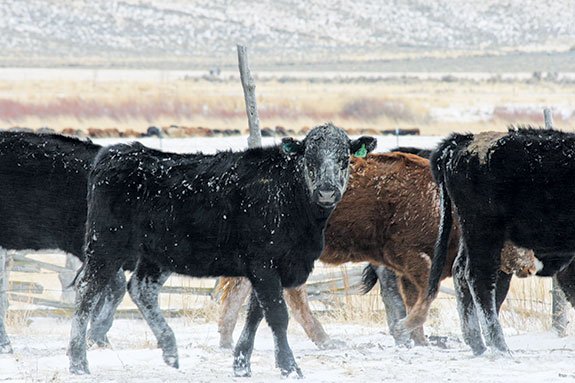Heavy mud can reduce average daily gain (ADG) by as much as one pound per day.
Anticipate these events and put cattle into a sacrifice area with hay for a few days.
To minimize bloat, make sure cattle are full before you turn them back out on small-grain pasture. Remember that electric fence has one big downfall – heavy ice.
9. Feed an ionophore
Ionophores such as Rumensin or Bovatec can increase ADG by 0.1 to 0.2 pound per day. They can be fed in supplements or in mineral.
Evidence is mounting that Rumensin is probably more effective than other ionophores in promoting gain and reducing the severity of bloat. Don’t let horses have access to any feed or mineral containing Rumensin.
8. Manage shrink
Reducing stress on cattle is key to reducing shrink. Allow cattle to fill up on pasture first thing in the morning and load them after they have grazed.
Train your cattle to be easy to catch by feeding them for a couple of weeks before marketing. Don’t catch them until the trucks show up. (I have seen cattle sit in the pens for two hours waiting on trucks.)
If your cattle are used to eating from a bunk, ensure they are fed at the sale barn, even if you have to feed them yourself. Check with the sale barn manager about their ability to feed.
7. Evaluate marketing alternatives
Learn to evaluate all possible marketing alternatives well before the end of the grazing season.
These include local sale barns, large regional sale barns, video/Internet sales or private treaty (“country”) sales. Also, you can “delay” marketing by retaining ownership into the feedlot.

6. Produce early pasture
If you are certain you will graze out small grains, strive to produce forage as early in the fall as you can. This can extend the fall/winter grazing season and reduce the need for supplemental feed.
Contact Noble Foundation soil fertility and crops specialists and forage specialists for pasture establishment recommendations.
5. Have a good health management program
A health management program should be a written plan, designed by you and your veterinarian, for how you are going to care for your cattle.
It should include identification, a vaccination program, diagnosis procedures, treatment protocols and morbidity/mortality targets.
4. Have an alternative feed source
Being able to buy cattle when no one has pasture, or being able to keep your cattle gaining through tough pasture conditions, can add tremendous flexibility to your operation.
Being able to handle byproduct feeds such as soybean hulls or wheat midds can significantly reduce the cost of supplemental feed.
3. Establish a profit objective
Before you buy cattle, determine how much profit per head you would be happy with. Figure that into your budget.
Keep an eye on the cattle market but, more importantly, watch the futures and options markets. Evaluate forward contracts with feedyards or buyers. If, during the grazing season, the opportunity to capture that profit comes along, you had better pay attention because it might not be there again.
2. Use implants
Growth-promoting implants are the single biggest “bang for the buck” you get in stocker production. A $0.75 implant can increase gain per head by 15 to 20 pounds.
If the value of those 20 pounds is $10, you get roughly 2,665 percent (annualized) return on your money.
1. Know your cost of production
You can’t determine if and when you have made an acceptable profit if you don’t know what it costs you to produce a feeder steer.
Additionally, cost of production is critical for evaluating cattle purchases next year. Call an agricultural economist at the Foundation for advice on how to gather this data.
References omitted due to space but are available upon request. Click here to email an editor.
Ryan Reuter is an assistant professor at the Noble Foundation.
PHOTOS
TOP: Take precautions so cattle don’t trample forage in icy or muddy conditions.
BOTTOM: Reducing stress on cattle is key to reducing shrink. Photos courtesy of Progressive Cattleman staff.






